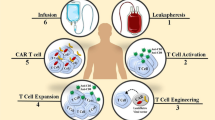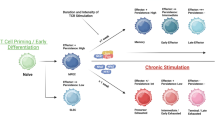Abstract
CAR-T therapy has shown successful in the treatment of certain types of hematological malignancy, while the efficacy of CAR-T cell in treating solid tumors has been limited due to the exhaustion of CAR-T caused by the tumor microenvironment in solid tumors. Therefore, improving the exhaustion of CAR-T cell is one of the inspiring strategies for CAR-T treatment of solid tumors. As an important regulator in T cell immunity, the transcription factor RUNX3 not only negatively regulates the terminal differentiation T-bet gene, reducing the ultimate differentiation of T cells, but also increases the residency of T cells in non-lymphoid tissues and tumors. By overexpressing RUNX3 in CAR-T cells, we found that increasing the expression of RUNX3 maintained the low differentiation of CAR-T cells, further improving the exhaustion of CAR-T cells during antigen stimulation. In vitro, we found that RUNX3 could reduce the release of cytokines while maintaining CAR-T cells function. In re-challenge experiments, CAR-T cells overexpressing RUNX3 (Runx3-OE CAR-T) were safer than conventional CAR-T cells, while RUNX3 could also maintain the anti-tumor efficacy of CAR-T cells in vivo. Collectively, we found that Runx3-OE CAR-T cells can improve CAR-T phenotype and reduce cytokines release while maintaining CAR-T cells function, which may improve the safety of CAR-T therapy in clinical trials.






Similar content being viewed by others
Data availability
The datasets used and/or analyzed during the current study are available from the corresponding author on reasonable request.
References
Kochenderfer JN, Dudley ME, Feldman SA, Wilson WH, Spaner DE, Maric I, et al. B-cell depletion and remissions of malignancy along with cytokine-associated toxicity in a clinical trial of anti-CD19 chimeric-antigen-receptor-transduced T cells[J]. Blood. 2012;119(12):2709–20.
Marofi F, Rahman HS, Al-Obaidi ZMJ, Jalil AT, Abdelbasset WK, Suksatan W, et al. Novel CAR T therapy is a ray of hope in the treatment of seriously ill AML patients[J]. Stem Cell Res Ther. 2021;12(1):465.
Scarfo I, Maus MV. Current approaches to increase CAR T cell potency in solid tumors: targeting the tumor microenvironment[J]. J Immunother Cancer. 2017;5:28.
Kyte JA. Strategies for improving the efficacy of CAR T cells in solid cancers[J]. Cancers. 2022;14(3):571.
Wang Z, Han W. Biomarkers of cytokine release syndrome and neurotoxicity related to CAR-T cell therapy[J]. Biomarker Res. 2018;6:4.
Giavridis T, van der Stegen SJC, Eyquem J, Hamieh M, Piersigilli A, Sadelain M. CAR T cell-induced cytokine release syndrome is mediated by macrophages and abated by IL-1 blockade[J]. Nat Med. 2018;24(6):731–8.
Li H, Zhao Y. Increasing the safety and efficacy of chimeric antigen receptor T cell therapy[J]. Protein Cell. 2017;8(8):573–89.
Morris EC, Neelapu SS, Giavridis T, Sadelain M. Cytokine release syndrome and associated neurotoxicity in cancer immunotherapy[J]. Nat Rev Immunol. 2022;22(2):85–96.
Zhang C, Wang Z, Yang Z, Wang M, Li S, Li Y, et al. Phase I escalating-dose trial of CAR-T Therapy Targeting CEA(+) metastatic colorectal cancers[J]. Molecular therapy : the journal of the American Society of Gene Therapy. 2017;25(5):1248–58.
Jiang Y, Li Y, Zhu B. T-cell exhaustion in the tumor microenvironment[J]. Cell Death Dis. 2015;6: e1792.
Wherry EJ. T cell exhaustion[J]. Nat Immunol. 2011;12(6):492–9.
Restifo NP. Big bang theory of stem-like T cells confirmed[J]. Blood. 2014;124(4):476–7.
Gattinoni L, Klebanoff CA, Restifo NP. Paths to stemness: building the ultimate antitumour T cell[J]. Nat Rev Cancer. 2012;12(10):671–84.
Kawalekar OU, O’Connor RS, Fraietta JA, Guo L, McGettigan SE, Posey AD Jr, et al. Distinct signaling of coreceptors regulates specific metabolism pathways and impacts memory development in CAR T Cells[J]. Immunity. 2016;44(2):380–90.
Kuznetsova M, Lopatnikova J, Shevchenko J, Silkov A, Maksyutov A, Sennikov S. Cytotoxic activity and memory t cell subset distribution of in vitro-stimulated CD8(+) T cells specific for HER2/neu Epitopes[J]. Front Immunol. 2019;10:1017.
Taniuchi I, Osato M, Egawa T, Sunshine MJ, Bae SC, Komori T, et al. Differential requirements for Runx proteins in CD4 repression and epigenetic silencing during T lymphocyte development[J]. Cell. 2002;111(5):621–33.
Egawa T. Runx and ThPOK: a balancing act to regulate thymocyte lineage commitment[J]. J Cell Biochem. 2009;107(6):1037–45.
Wong WF, Kohu K, Chiba T, Sato T, Satake M. Interplay of transcription factors in T-cell differentiation and function: the role of Runx[J]. Immunology. 2011;132(2):157–64.
Shan Q, Zeng Z, Xing S, Li F, Hartwig SM, Gullicksrud JA, et al. The transcription factor Runx3 guards cytotoxic CD8(+) effector T cells against deviation towards follicular helper T cell lineage[J]. Nat Immunol. 2017;18(8):931–9.
Lotem J, Levanon D, Negreanu V, Leshkowitz D, Friedlander G, Groner Y. Runx3-mediated transcriptional program in cytotoxic lymphocytes[J]. PLoS ONE. 2013;8(11): e80467.
Milner JJ, Toma C, Yu B, Zhang K, Omilusik K, Phan AT, et al. Runx3 programs CD8(+) T cell residency in non-lymphoid tissues and tumours[J]. Nature. 2017;552(7684):253–7.
Pei WC, Hu J, Song JH, Wang WF, He YY, Pang WJ, et al. Effects of CAR structure and culture conditions on memory CAR-T cells[J]. Eur Rev Med Pharmacol Sci. 2021;25(5):2313–7.
Golubovskaya V, Wu L. Different subsets of T cells, memory, effector functions, and CAR-T immunotherapy[J]. Cancers. 2016;8(3):36.
Turtle CJ, Hanafi LA, Berger C, Hudecek M, Pender B, Robinson E, et al. Immunotherapy of non-Hodgkin’s lymphoma with a defined ratio of CD8+ and CD4+ CD19-specific chimeric antigen receptor-modified T cells[J]. Sci Transl Med. 2016. https://doi.org/10.1126/scitranslmed.aaf8621.
Sommermeyer D, Hudecek M, Kosasih PL, Gogishvili T, Maloney DG, Turtle CJ, et al. Chimeric antigen receptor-modified T cells derived from defined CD8+ and CD4+ subsets confer superior antitumor reactivity in vivo[J]. Leukemia. 2016;30(2):492–500.
Klebanoff CA, Gattinoni L, Torabi-Parizi P, Kerstann K, Cardones AR, Finkelstein SE, et al. Central memory self/tumor-reactive CD8+ T cells confer superior antitumor immunity compared with effector memory T cells[J]. Proc Natl Acad Sci USA. 2005;102(27):9571–6.
Ando M, Ito M, Srirat T, Kondo T, Yoshimura A. Memory T cell, exhaustion, and tumor immunity[J]. Immunological medicine. 2020;43(1):1–9.
Angelosanto JM, Blackburn SD, Crawford A, Wherry EJ. Progressive loss of memory T cell potential and commitment to exhaustion during chronic viral infection[J]. J Virol. 2012;86(15):8161–70.
Baitsch L, Legat A, Barba L, Fuertes Marraco SA, Rivals JP, Baumgaertner P, et al. Extended co-expression of inhibitory receptors by human CD8 T-cells depending on differentiation, antigen-specificity and anatomical localization[J]. PLoS ONE. 2012;7(2): e30852.
Rafiq S, Yeku OO, Jackson HJ, Purdon TJ, van Leeuwen DG, Drakes DJ, et al. Targeted delivery of a PD-1-blocking scFv by CAR-T cells enhances anti-tumor efficacy in vivo[J]. Nat Biotechnol. 2018;36(9):847–56.
Nie J, Wang C, Liu Y, Yang Q, Mei Q, Dong L, et al. Addition of low-dose decitabine to Anti-PD-1 antibody camrelizumab in relapsed/refractory classical hodgkin lymphoma[J]. J Clin Oncol. 2019;37(17):1479–89.
Yan G, Du Q, Wei X, Miozzi J, Kang C, Wang J, et al. Application of real-time cell electronic analysis system in modern pharmaceutical evaluation and analysis[J]. Molecules (Basel, Switzerland). 2018;23(12):3280.
Yah CS, Simate GS. Engineered nanoparticle bio-conjugates toxicity screening: The xCELLigence cells viability impact[J]. Bioimpacts. 2020;10(3):195–203.
Li X, Shao M, Zeng X, Qian P, Huang H. Signaling pathways in the regulation of cytokine release syndrome in human diseases and intervention therapy[J]. Signal Transduct Target Ther. 2021;6(1):367.
Weber EW, Parker KR, Sotillo E, Lynn RC, Anbunathan H, Lattin J, et al. Transient rest restores functionality in exhausted CAR-T cells through epigenetic remodeling[J]. Science. 2021. https://doi.org/10.1126/science.aba1786.
Lamers CHJ, Sleijfer S, van Steenbergen S, van Elzakker P, van Krimpen B, Groot C, et al. Treatment of metastatic renal cell carcinoma With CAIX CAR-engineered T cells: Clinical evaluation and management of on-target toxicity[J]. Mol Ther. 2013;21(4):904–12.
Parkhurst MR, Yang JC, Langan RC, Dudley ME, Nathan DAN, Feldman SA, et al. T cells targeting carcinoembryonic antigen can mediate regression of metastatic colorectal cancer but induce severe transient colitis[J]. Mol Therapy. 2011;19(3):620–6.
Cherkassky L, Hou Z, Amador-Molina A, Adusumilli PS. Regional CAR T cell therapy: An ignition key for systemic immunity in solid tumors[J]. Cancer Cell. 2022;40(6):569–74.
Shimabukuro-Vornhagen A, Gödel P, Subklewe M, Stemmler HJ, Schlößer HA, Schlaak M, et al. Cytokine release syndrome[J]. J Immunother Cancer. 2018;6(1):56.
Acknowledgements
Not applicable
Funding
This work is supported by grants from the National Natural Science Foundation of China (81903157, to CC. Zhang.)
Author information
Authors and Affiliations
Contributions
Cheng Qian and Chengcheng Zhang designed the research study. Xiuxiu Zhu performed the research. Wuling Li and Jiadong Gao conducted the flow cytometry tests. Junjie Shen and Yanmin Xu cultivated CAR-T cells. Xiuxiu Zhu wrote the paper.
Corresponding authors
Ethics declarations
Competing interests
The CAR-T cells and detection methods of this experiment came from Chongqing Institute of Precision Medicine and Biotechnology Co., Ltd. The authors declare no conflict interests.
Ethical approval
All procedures were approved by the China Council on Animal Care and Chongqing Institute of Precision Medicine and Biotechnology Co., Ltd.
Consent to participate
All procedures were approved by the China Council on Animal Care and Chongqing Institute of Precision Medicine and Biotechnology Co., Ltd.
Consent for publication
Not applicable.
Additional information
Publisher's Note
Springer Nature remains neutral with regard to jurisdictional claims in published maps and institutional affiliations.
Supplementary Information
Below is the link to the electronic supplementary material.
Rights and permissions
Springer Nature or its licensor (e.g. a society or other partner) holds exclusive rights to this article under a publishing agreement with the author(s) or other rightsholder(s); author self-archiving of the accepted manuscript version of this article is solely governed by the terms of such publishing agreement and applicable law.
About this article
Cite this article
Zhu, X., Li, W., Gao, J. et al. RUNX3 improves CAR-T cell phenotype and reduces cytokine release while maintaining CAR-T function. Med Oncol 40, 89 (2023). https://doi.org/10.1007/s12032-022-01913-7
Received:
Accepted:
Published:
DOI: https://doi.org/10.1007/s12032-022-01913-7




